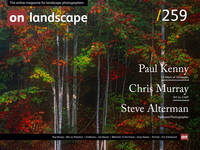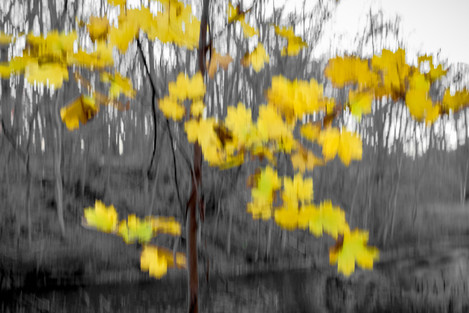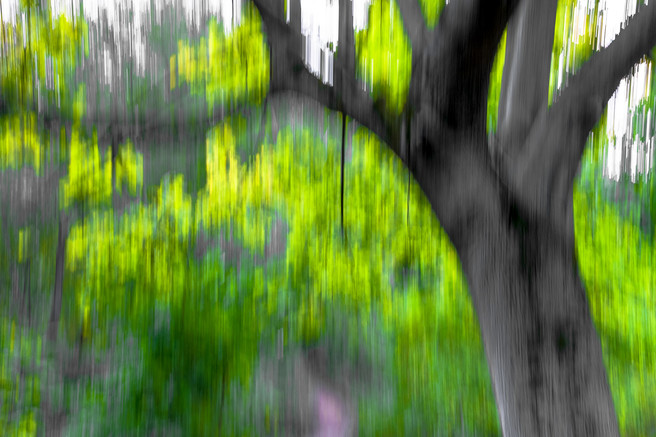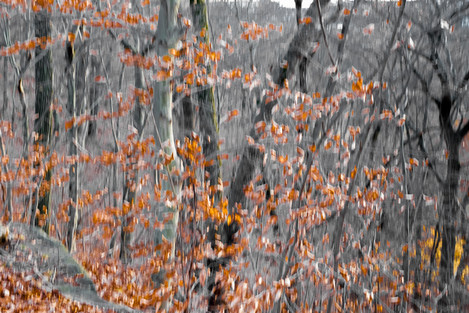The achievement of undivided attention

Roy Money
I grew up in the rural south of the USA and the woods were central to my childhood. One of my early photographic inspirations was Elliot Porter’s In Wildness is the Preservation of the World. The natural environment is my typical subject matter because of its many opportunities to lose myself in the process of perception, not unlike listening to captivating music, but in this case I try to find expression for the uniqueness of those moments when a camera in hand motivates me to look more closely.
Several years ago, I made a conventional exposure of birch trees in the morning sunlight that seemed inadequate to convey the surprise of my encounter. Suddenly, I got an impulse to try again and move the camera during exposure. The result appeared to express a visual vibration more commensurate with my experience of the trees. I did not see the trees move, but I felt a visceral internal movement. Before I made this exposure, I had seen a few examples of intentional camera movement. Still, I did not know ICM was an established method. I subsequently experimented periodically with this, but it was such a departure from my usual way of working that I was reluctant to pursue it at the time.
The lack of sharpness in these pictures challenged me. Clear and precise rendering of details and texture has long been a primary consideration in my photographs. Did a visual conceit of blurred images make sense for me as a photographer? The natural landscape has been my continuing preoccupation for the last two decades. I like to think my photography affirms solidarity with the nature around me. If I admire and respect the forms of this voluminous universe of beings, why would I want to present it as blurred?
In the throes of COVID, I picked up this thread again, and somehow my results seemed more promising. I did not use long exposures because I wanted to preserve some semblance of the identity of the forms before the camera. I wanted to convey a sense of their aliveness. However, I continued to wonder about my departure from realism. I wasn't sure where this path would lead, but I knew I would not find out if I didn't explore it. So I continued to work with intentional camera movement and considered my understanding of photography and visual perception. .
One of the original appeals of photography was accurately depicting the physical world, unaffected by an artist's skill or interpretation. Though this was a mistaken presumption, photographs are still associated with descriptive accuracy and can be seen as a direct representation of reality. The desire to see things as they are without bias is critical to human intelligence. In that regard, I have been curious for many years about phenomenology - a study of things as they are in themselves, in the most immediate sense of how we experience them, without any assumptions, just what is before us.1 That approach seemed akin to photography's emphasis on what is real. However, phenomenology explores sensory stimuli in its many sources.
When I read David Abram's The Spell of the Sensuous2, it inspired me to rethink the process of awareness. Abram is a philosopher known for applying phenomenology to ecological issues and his perspective resonated with my experience as an artist and nature photographer. In retrospect, Abram's writing seems an essential clue to what I find appealing in these pictures I have persisted in making, despite my uncertainty about them. For Abram, phenomenology is a way to rediscover the perceived world as an interactive one. To see something is to become a host for what we see, however awarely. Even if we are walking unaware in a park, we still interact with the trees through the subliminal calming effect of the sights and sounds. The absence of this kind of experience is associated with what has been called "nature deficit disorder."3 But whatever the consequences, we are always within a field of sensory stimuli, interacting with it in ways dependent on our attention and the brain's processing of sensory information.
The issue of attentiveness is a key one for any artist or craftsperson. The achievement of undivided attention is often called mindfulness: when a person is not preoccupied with the past, future, or judgment. Such a mind is, at its best, open as fully as possible to the present moment and the body's spectrum of sensory stimuli. Of course, there are degrees of mindfulness, and the full extent of this attentiveness might be called acceptance – a mind that neither excludes nor judges what is before it.
The idea of mindfulness has become a cultural buzzword after being introduced by Jon Kabot-Zin as a stress reduction program at the UMass medical school in 1979. Though Zinn's work was inspired by Buddhist teachings, his medical research, and subsequently that of many others, has shown considerable evidence for the value of mindfulness. However, it is widely unknown that mindfulness was a central idea for early 20th-century phenomenologists Edmund Husserl, Martin Heidegger, and Maurice Merleau-Ponty6. Husserl called for a study of things-in-themselves and for living contact with the here-and-now. For all three seminal thinkers, mindfulness was about the life-world, the world of experience, before sensory awareness transforms into knowledge. For Heidegger, encountering a tree is a two-way experience; to be mindful is to savor its presence and wonder about its existence.7
For Maurice Merleau-Ponty, a principal inspiration for David Abram, the body was not something we have but something we are, the way we experience the world. Our body is what enables our sensory awareness, just like with all other beings in the tree of life. Hence direct embodied experience is regarded by Merleau-Ponty as pre-objective and primordial.8 Perception can allow sensible things to inhabit us experientially, depending on our receptivity and resonance with the experience. For Merleau-Ponty, art was a way to express this primordial experience and return us to the life-world.
Regarding visual sensation, research indicates that human vision involves rapid eye movement to explore what is before us, even when maintaining a steady gaze. The conventional static image we associate with stationary objects seems to result from neural processing that stabilises eye movement differences and associates the visual data with words and concepts.9 Though I cannot recover my eye motion during a static subject encounter, I found this research intriguing and suggestive of a more direct experience of micro-moments latent in the perceptual process. Moreover, it is unlikely that any memorable visual experience is static. We move our head to take in what is right and left; we move our body closer to see detail and back to see the context. Seeing involves motion when we are paying attention.
Though representing objects at rest is necessary for documenting details in science, art, or daily life, it also reinforces what phenomenologists call the "natural attitude."10 Indeed, it is customary to see the visual world as a collection of objects from which we are fundamentally independent. Of course, our body is physically separate from the things we see, but we only see them because we are attending to them. There is no "seen" without a "seer." For these pictures, it is as if I do not see them as objects but as interactions. The blur in these pictures records moments when things appear in time rather than being taken out of time. I like to think that the blurring displaces my internal animation back to its source as a vibration that resonates with me.
References
- DW Smith, Phenomenology
- David Abram, The Spell of the Sensuous, New York Vintage;1997
- Richard Louv et al., what-is-nature-deficit-disorder
- Frederick Sommer, Quotes
- White, Minor. The Way Through Camera Work. Aperture, Vol.7, No. 2, New York 1959
- Andrew Felde et al., Mindfulness_at_the_Heart_of_Existential Phenomenolog
- Charles Atkins, Heidegger and Mindfulness
- Dan Nixon, The Body as Mediator
- Bruno Olshausen et al., Does the Brain Dejigger Retinal Images?
- Melanie Walton, Phenomenology










